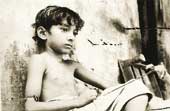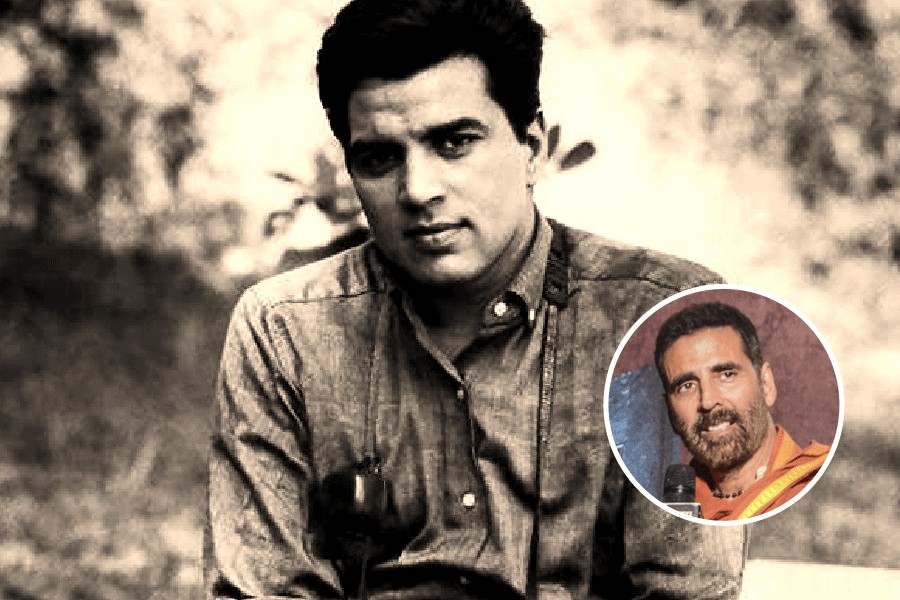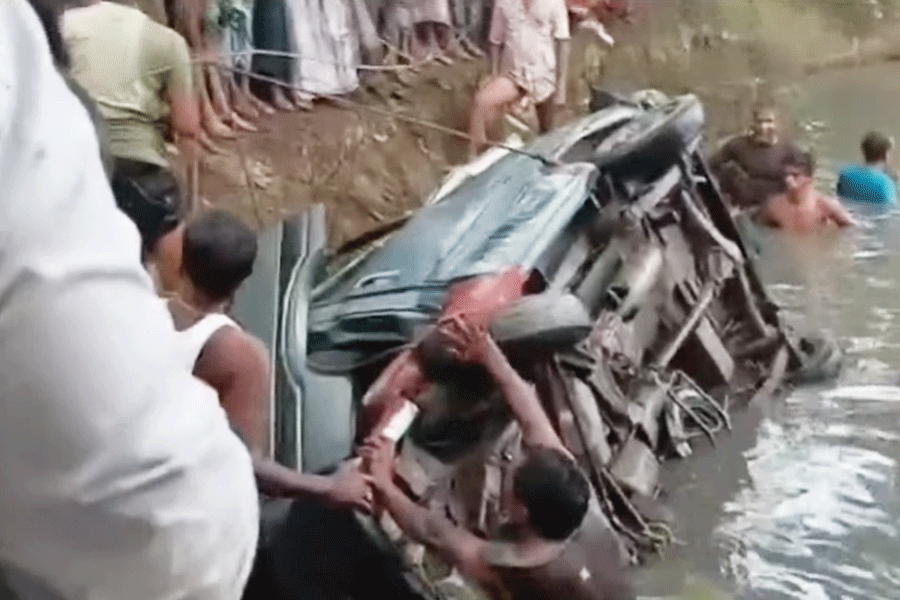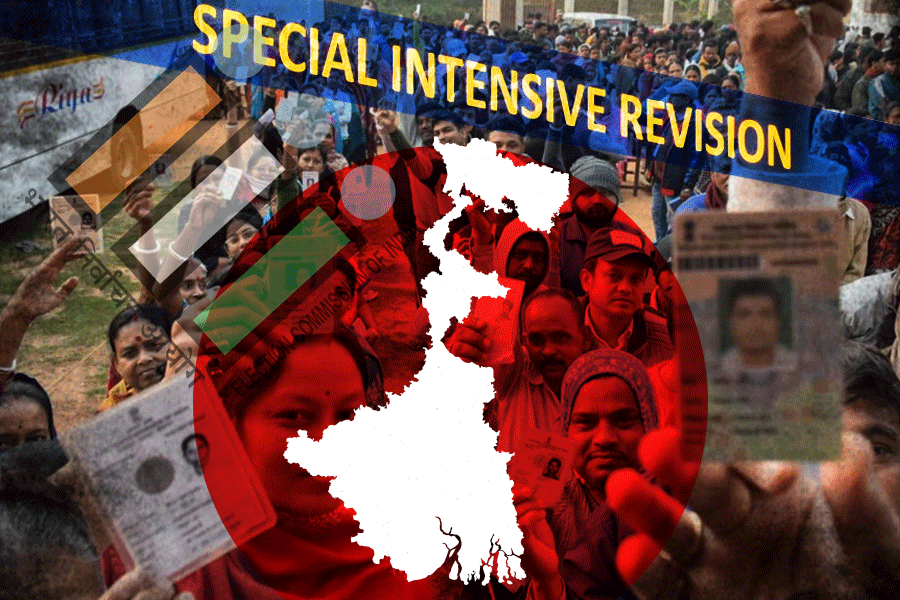 |
SUBIR BANERJEE: I was just nine years old . We used to live at 31 Lake Avenue and Satyajit Ray was our neighbour. Still, I didn?t know him very well. One day, I saw a stranger come to our house. I was called into the room. He approached my father saying he needed me for his film. Initially, my father did not agree. But then Manik kaku told him: ?Today, no one knows your son or me. But I?ll make a film that will change Bengali cinema. Then, all of Bengal will know both of us.? My father was convinced. Perhaps it was the sincerity in Ray?s words.
 |
| Sunny Side up: Tiny tots take part in a spring festival, organised by Bridge International School. There was an original play, folk dances, a Korean orchestra, a French song and festivals of the world were part of the programme. Picture by Sanjoy Chattopadhyaya |
Filming started in 1952 and ended in 1954. But the film had to be stopped midway because we ran out of funds. Manik kaku was very depressed. So were we. But shooting started again when former chief minister Bidhan Chandra Roy helped us by giving Rs 2 lakh.
We really enjoyed acting. The surroundings and the crew helped us a lot. In fact, the name of the village where the shooting was done was Nishchindipur (the name of the village in Bibhutibhushan?s story was also Nishchindipur). I still remember how excited we were when we first went to see the train in Shaktigarh.
The film was released on August 26, 1955. It barely ran for a week. But it won awards in international film festivals, like in Manila. After that, all the shows ran house full in Calcutta. The film won ?best human deed? award and I got the ?best child actor? prize. But I could not go to Manila as I had typhoid. Bidhan Chandra Roy, on behalf of the West Bengal government and also the BFJA, felicitated us later, but we were never honoured by the central government.
As a retired person now, when I think of those days it brings tears to my eyes. I feel very nostalgic. But I was very surprised when in the 50 years? celebration of Pather Panchali, held during this year?s Calcutta Film Festival, we weren?t invited.
 |
UMA DASGUPTA: I was in Class VIII, 12 years old then . Satyajit Ray was looking for someone who could play the character of Durga. Ashish Burman, who was a friend of both Ray and the assistant headmaster of our school, discussed the matter with the assistant headmaster. He recommended me. I went to Manikda?s home. He saw me and was very happy.
While filming, we never felt we were shooting for a movie. It was almost like a picnic. Manikda was so kind to us. He never scolded us. If we made any mistakes, he told us repeatedly where we went wrong until the final shot was taken.
The excitement of seeing the train, placing our ears to the railway tracks to listen to the sound of the train approaching from afar, playing with the aam aantir bhepu ? I still cherish those memories. As we were young, our food used to come from Ray?s home. One day, Kishore Kumar and Ruma Guha Thakurta came to see the shooting. They inspired us a lot. We talked to them for hours.
When I saw the film for the first time, I didn?t like my own acting. But I cried a lot when Durga died and when Apu left for Calcutta leaving his village behind.
Till 1966, the film had won 12 international awards. A special screening was done on Fifth Avenue in New York for students and I was voted ?teenager of the year?.
 |
| Actors Arindam Sil (left) and Rajatabha Datta interact with underprivileged children at a carnival organised by Rotaract Club of Calcutta Midtown, at Loreto House. Around 250 kids from orphanages, broken homes, the Rainbow project of Loreto Sealdah and streetchildren joined in the fun. Picture by Sanjoy Chattopadhyaya |
Education for all
Bodhodaya began almost 10 years ago, with only a handful of students. Today, after facing its fair share of problems and hiccups, it has emerged a winner. Boasting a student strength of 120 underprivileged children, Bodhodaya looks after their safety, well being and wholesome development of knowledge and discipline.
Speaking of the reach of the school, principal Sunetra Majumder says, ? We are trying our best to teach the children of the economically weaker section of our area, around Motilal Nehru Road, Manoharpukur Road and Deshapriya Park.?
Bodhodaya helps its students discover the colours of life through annual social celebrations, just before Durga puja, and the sports day in January. Helping further the cause, the Calcutta Municipal Corporation arranged an extra classroom for them. Rotary Club of Dhakuria has promised support. With the help of three graduate teachers and an assistant, Majumder is set to widen the reach of the school.
Nirmalya Mazumder
 |
| Toddlers of Greenage Montessori House perform on stage. Picture by Pabitra Das |
Non-violent words
A coffee table discussion: how often do we think about how much violence has become a part of life? What provokes us to behave violently? It happens right under our noses. Its impact has become a global issue. Children are victims of this silent killer. The question arises: what is violence and what is our understanding of it? How much has society absorbed its evil effects?
AIESECers came up with the first coffee table discussion on the issue. It was the first event of their projects based on exchanges highlighting the issues of children which affect them the most and prevent them from having happy childhoods. Stephen Gonsalves of Calcutta Urban Services facilitated the event.
It began with the movie Peace to Cities: And Stories of Hope. At the end, there was silence, because it portrayed the harsh reality of violence and highlighted attempts to overcome violence through non-violence.
The discussion had participation from people of all ages, talking about their perceptions of the movie, about violence and how we can overcome it with non-violence. We began by highlighting the undertones of violence in communication, like the use of slang and abusive words in conversation.
It emerged that we lack compassion and seldom articulate our deeper needs and feelings and therefore, the seeds of violence are sown. Non-violent communication is a process of self-discovery by understanding our own and others? need. It is about listening and empathy. A realistic picture of the impact of violence on today?s youth is visible in the tragedy that is the lives of youngsters addicted to cigarettes, alcohol and drugs.
Young people suffer from anxiety, from violence in all its forms. Communication is the key. Non-violent communication helps us connect with what we or others could do to make life more meaningful, and with an awareness of what gets in the way of giving and receiving. It strengthens our compassion, guides us in expressing ourselves, how we hear others and resolve conflicts.
We learn to hear our own deeper needs and those of others, and to identify and articulate them. When we focus on clarifying what is being observed, felt and needed, rather than on diagnosing and judging, we discover the depth of our own compassion. Through its emphasis on deep listening it fosters respect, attentiveness and empathy, and engenders a desire to give from the heart. Check out www.cnvc.org.
Suchita Sahal
 |
| Odissi dancers Attreyi Majumdar and Kaberi Sen perform at the start of the Judges Choice Young Dancers Festival organised by Padatik Dance Centre. Eleven young talents from four forms of Indian classical dance performed at the programme. Picture by Sanjoy Chattopadhyaya |
Crusaders? capers
Our wildlife is under threat due to our own ignorance and negligence. But one group of youngsters has come forward to crusade for the well being of the environment. Instinct has resolved to enlighten society about the need to preserve wildlife. In the past two years, they have done their fair share, but this bunch feels there?s plenty more animal life in need of rescuing.
For the last five months, Instinct has been involved in a project to stop the selling of endangered terrapines and rescue them. Terrapines have been included under schedule two by the forest department, which means they are among the most endangered of species.
Every morning, mass killing of terrapines is done in the Chowbhaga and Bantala market areas, two villages about 10 minutes from Anandapur, on the EM Bypass. ?The exact place from where the terrapines are brought are not known yet. We think they are brought from places far south of Bengal,? says Suvrajyoti Chatterjee, the brain behind this project. ?For five months I have been going there regularly. I need to establish friendships with them to get information. But if they find out my real motives, my life could be in danger.?
Fear writ large on his face, the first year college student confesses: ?I haven?t told my parents about this matter, otherwise they would not have allowed me to go.? Based on information given by Instinct, forest department officials raided the place on January 2 and rescued 40 terrapines, and even made it on the news on a Bengali channel. But the killing continues.
A few days ago, some members of Instinct seized a vine snake (loudaga) and an ornamental snake (kalnagini) from a snake charmer. But local people forced them to release the snakes. ?We faced public rage when we seized those snakes. So we had to surrender,? said Suvrajyoti. But the bravehearts did not give up. They informed the police, who then rescued the snakes.
Instinct is planning to hit the lanes and bylanes of Calcutta and its suburbs with roadshows on reptiles. The group is backed by their patron, Dipak Mitra, and his organisation, Calcutta Snake Park. But it is not possible for one organisation alone to protect wildlife. We must join hands. Its time we stopped turning a blind eye.
Subhajoy Roy











